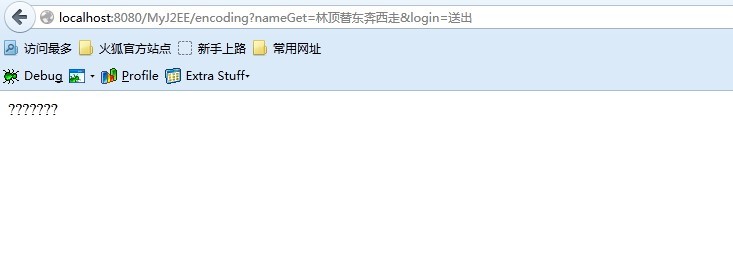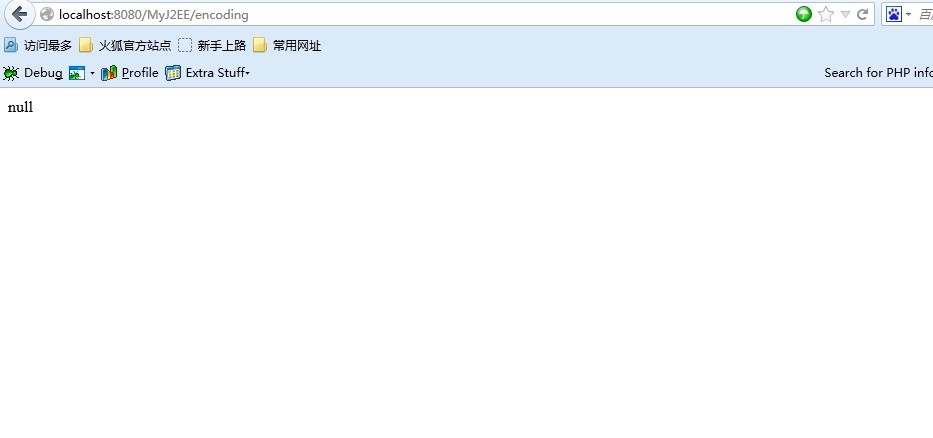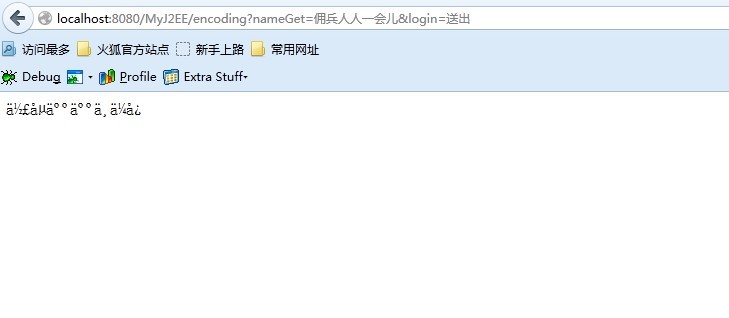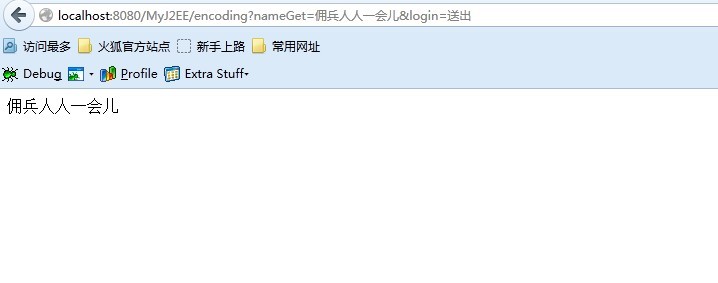67,543
社区成员
 发帖
发帖 与我相关
与我相关 我的任务
我的任务 分享
分享
package cc.openhome;
import java.io.BufferedReader;
import java.io.PrintWriter;
import java.io.IOException;
import java.util.Enumeration;
import javax.servlet.ServletException;
import javax.servlet.annotation.WebServlet;
import javax.servlet.http.HttpServlet;
import javax.servlet.http.HttpServletRequest;
import javax.servlet.http.HttpServletResponse;
/**
* Servlet implementation class HelloServlet
*/
@WebServlet("/encoding")
public class HelloServlet extends HttpServlet {
private static final long serialVersionUID = 1L;
/**
* @see HttpServlet#HttpServlet()
*/
public HelloServlet() {
super();
// TODO Auto-generated constructor stub
}
/**
* @see HttpServlet#doGet(HttpServletRequest request, HttpServletResponse response)
*/
@Override
protected void doGet(HttpServletRequest request, HttpServletResponse response) throws ServletException, IOException {
// TODO Auto-generated method stub
String name = request.getParameter("nameGet");
name = new String(name.getBytes("ISO-8859-1"), "UTF-8");
PrintWriter out = response.getWriter();
response.setContentType("text/html;charset=utf-8");
out.println("<html>");
out.println("<head>");
out.println("<title>Hello</title>");
out.println("</head>");
out.println("<body>" + name + "</body>");
out.println("</html>");
}
/**
* @see HttpServlet#doPost(HttpServletRequest request, HttpServletResponse response)
*/
@Override
protected void doPost(HttpServletRequest request, HttpServletResponse response) throws ServletException, IOException {
// TODO Auto-generated method stub
request.setCharacterEncoding("UTF-8");
String name = request.getParameter("namePost");
PrintWriter out = response.getWriter();
response.setContentType("text/html;charset=utf-8");
out.println("<html>");
out.println("<head>");
out.println("<title>Hello</title>");
out.println("</head>");
out.println("<body>" + name + "</body>");
out.println("</html>");
}
}
<?xml version="1.0" encoding="UTF-8" ?>
<!DOCTYPE html PUBLIC "-//W3C//DTD XHTML 1.0 Transitional//EN" "http://www.w3.org/TR/xhtml1/DTD/xhtml1-transitional.dtd">
<html xmlns="http://www.w3.org/1999/xhtml">
<head>
<meta http-equiv="Content-Type" content="text/html; charset=UTF-8" />
<title>Insert title here</title>
</head>
<body>
<form action="encoding" method="get">
名称:<input type="text" name="nameGet" /><br />
<input type="submit" name="login" value="送出" />
</form>
</body>
</html>


protected void doGet(HttpServletRequest request, HttpServletResponse response) throws ServletException, IOException {
// TODO Auto-generated method stub
response.setContentType("text/html;charset=UTF-8");
String name = request.getParameter("nameGet");
//name = new String(name.getBytes("ISO-8859-1"), "UTF-8");
PrintWriter out = response.getWriter();
out.println("<html>");
out.println("<head>");
out.println("<title>Hello</title>");
out.println("</head>");
out.println("<body>" + name + "</body>");
out.println("</html>");
}
 明显显示是乱码;
如果我写上getBytes:
明显显示是乱码;
如果我写上getBytes:
@Override
protected void doGet(HttpServletRequest request, HttpServletResponse response) throws ServletException, IOException {
// TODO Auto-generated method stub
response.setContentType("text/html;charset=UTF-8");
String name = request.getParameter("nameGet");
name = new String(name.getBytes("ISO-8859-1"), "UTF-8");
PrintWriter out = response.getWriter();
out.println("<html>");
out.println("<head>");
out.println("<title>Hello</title>");
out.println("</head>");
out.println("<body>" + name + "</body>");
out.println("</html>");
}
 [/quote]
你还是没看明白。
uri解码跟你使用的服务器有关,你用tomcat的话先检查server。xml里的设置!
字符串到java servlet那里URI已经是被解码过了一遍了。
encoding有两层,
一层意思叫URL encoding是按RFC 3986 标准。另外URL本身也有编码标准。
另一层意思是字符集的二进制转换UTF-8,ISO8895 等。
很多文章绝大多数上都把两者混为一谈,有时候得到的结果是对的,因为刚好在某些点上兼容了,但原理是错的。
比如你上面的问题,出问题的地方不止一个,所以你会得到似是而非的结论。
首先
String name = request.getParameter("nameGet");
System.out.println(name);//加上
如果name print出来是对的。
那么浏览器上得到输出应该不会是乱码。
如果name输出不正常,说明你server的解码没设对。
浏览器对URL的编码标准是UTF-8。如果server的解码设的是ISO8895 的话
那必然name print出来是乱码。
这里的过程是这样的,浏览器发送字串name-》编码成UTF-8 bytes-》bytes 》被server按ISO解读-》乱码字串name。
接下来,你的servlet把
乱码字串name -》编码成 ISO bytes-》bytes 》被按UTF-8解读 -》正常字串name -》输出到response
看到问题了吗,这个字串被来来回回套了两层编码,这完全是不必要的。
如果服务器设置是对的话,这个过程应该是这样的。
浏览器发送字串name-》编码成UTF-8 bytes-》bytes 》被server按UTF-8解读-》正常字串name
然后,你的servlet里 只需要 正常字串name -》输出到response 就可以了。
[/quote]
[/quote]
你还是没看明白。
uri解码跟你使用的服务器有关,你用tomcat的话先检查server。xml里的设置!
字符串到java servlet那里URI已经是被解码过了一遍了。
encoding有两层,
一层意思叫URL encoding是按RFC 3986 标准。另外URL本身也有编码标准。
另一层意思是字符集的二进制转换UTF-8,ISO8895 等。
很多文章绝大多数上都把两者混为一谈,有时候得到的结果是对的,因为刚好在某些点上兼容了,但原理是错的。
比如你上面的问题,出问题的地方不止一个,所以你会得到似是而非的结论。
首先
String name = request.getParameter("nameGet");
System.out.println(name);//加上
如果name print出来是对的。
那么浏览器上得到输出应该不会是乱码。
如果name输出不正常,说明你server的解码没设对。
浏览器对URL的编码标准是UTF-8。如果server的解码设的是ISO8895 的话
那必然name print出来是乱码。
这里的过程是这样的,浏览器发送字串name-》编码成UTF-8 bytes-》bytes 》被server按ISO解读-》乱码字串name。
接下来,你的servlet把
乱码字串name -》编码成 ISO bytes-》bytes 》被按UTF-8解读 -》正常字串name -》输出到response
看到问题了吗,这个字串被来来回回套了两层编码,这完全是不必要的。
如果服务器设置是对的话,这个过程应该是这样的。
浏览器发送字串name-》编码成UTF-8 bytes-》bytes 》被server按UTF-8解读-》正常字串name
然后,你的servlet里 只需要 正常字串name -》输出到response 就可以了。
[/quote]
 好强大的回复!!!
好强大的回复!!!
protected void doGet(HttpServletRequest request, HttpServletResponse response) throws ServletException, IOException {
// TODO Auto-generated method stub
response.setContentType("text/html;charset=UTF-8");
String name = request.getParameter("nameGet");
//name = new String(name.getBytes("ISO-8859-1"), "UTF-8");
PrintWriter out = response.getWriter();
out.println("<html>");
out.println("<head>");
out.println("<title>Hello</title>");
out.println("</head>");
out.println("<body>" + name + "</body>");
out.println("</html>");
}
 明显显示是乱码;
如果我写上getBytes:
明显显示是乱码;
如果我写上getBytes:
@Override
protected void doGet(HttpServletRequest request, HttpServletResponse response) throws ServletException, IOException {
// TODO Auto-generated method stub
response.setContentType("text/html;charset=UTF-8");
String name = request.getParameter("nameGet");
name = new String(name.getBytes("ISO-8859-1"), "UTF-8");
PrintWriter out = response.getWriter();
out.println("<html>");
out.println("<head>");
out.println("<title>Hello</title>");
out.println("</head>");
out.println("<body>" + name + "</body>");
out.println("</html>");
}
 [/quote]
你还是没看明白。
uri解码跟你使用的服务器有关,你用tomcat的话先检查server。xml里的设置!
字符串到java servlet那里URI已经是被解码过了一遍了。
encoding有两层,
一层意思叫URL encoding是按RFC 3986 标准。另外URL本身也有编码标准。
另一层意思是字符集的二进制转换UTF-8,ISO8895 等。
很多文章绝大多数上都把两者混为一谈,有时候得到的结果是对的,因为刚好在某些点上兼容了,但原理是错的。
比如你上面的问题,出问题的地方不止一个,所以你会得到似是而非的结论。
首先
String name = request.getParameter("nameGet");
System.out.println(name);//加上
如果name print出来是对的。
那么浏览器上得到输出应该不会是乱码。
如果name输出不正常,说明你server的解码没设对。
浏览器对URL的编码标准是UTF-8。如果server的解码设的是ISO8895 的话
那必然name print出来是乱码。
这里的过程是这样的,浏览器发送字串name-》编码成UTF-8 bytes-》bytes 》被server按ISO解读-》乱码字串name。
接下来,你的servlet把
乱码字串name -》编码成 ISO bytes-》bytes 》被按UTF-8解读 -》正常字串name -》输出到response
看到问题了吗,这个字串被来来回回套了两层编码,这完全是不必要的。
如果服务器设置是对的话,这个过程应该是这样的。
浏览器发送字串name-》编码成UTF-8 bytes-》bytes 》被server按UTF-8解读-》正常字串name
然后,你的servlet里 只需要 正常字串name -》输出到response 就可以了。
[/quote]
那么这个server.xml哪里需要改编码的??麻烦帮我看一下:
[/quote]
你还是没看明白。
uri解码跟你使用的服务器有关,你用tomcat的话先检查server。xml里的设置!
字符串到java servlet那里URI已经是被解码过了一遍了。
encoding有两层,
一层意思叫URL encoding是按RFC 3986 标准。另外URL本身也有编码标准。
另一层意思是字符集的二进制转换UTF-8,ISO8895 等。
很多文章绝大多数上都把两者混为一谈,有时候得到的结果是对的,因为刚好在某些点上兼容了,但原理是错的。
比如你上面的问题,出问题的地方不止一个,所以你会得到似是而非的结论。
首先
String name = request.getParameter("nameGet");
System.out.println(name);//加上
如果name print出来是对的。
那么浏览器上得到输出应该不会是乱码。
如果name输出不正常,说明你server的解码没设对。
浏览器对URL的编码标准是UTF-8。如果server的解码设的是ISO8895 的话
那必然name print出来是乱码。
这里的过程是这样的,浏览器发送字串name-》编码成UTF-8 bytes-》bytes 》被server按ISO解读-》乱码字串name。
接下来,你的servlet把
乱码字串name -》编码成 ISO bytes-》bytes 》被按UTF-8解读 -》正常字串name -》输出到response
看到问题了吗,这个字串被来来回回套了两层编码,这完全是不必要的。
如果服务器设置是对的话,这个过程应该是这样的。
浏览器发送字串name-》编码成UTF-8 bytes-》bytes 》被server按UTF-8解读-》正常字串name
然后,你的servlet里 只需要 正常字串name -》输出到response 就可以了。
[/quote]
那么这个server.xml哪里需要改编码的??麻烦帮我看一下:
<?xml version="1.0" encoding="UTF-8"?>
<!--
Licensed to the Apache Software Foundation (ASF) under one or more
contributor license agreements. See the NOTICE file distributed with
this work for additional information regarding copyright ownership.
The ASF licenses this file to You under the Apache License, Version 2.0
(the "License"); you may not use this file except in compliance with
the License. You may obtain a copy of the License at
http://www.apache.org/licenses/LICENSE-2.0
Unless required by applicable law or agreed to in writing, software
distributed under the License is distributed on an "AS IS" BASIS,
WITHOUT WARRANTIES OR CONDITIONS OF ANY KIND, either express or implied.
See the License for the specific language governing permissions and
limitations under the License.
--><!-- Note: A "Server" is not itself a "Container", so you may not
define subcomponents such as "Valves" at this level.
Documentation at /docs/config/server.html
--><Server port="8005" shutdown="SHUTDOWN">
<!-- Security listener. Documentation at /docs/config/listeners.html
<Listener className="org.apache.catalina.security.SecurityListener" />
-->
<!--APR library loader. Documentation at /docs/apr.html -->
<Listener SSLEngine="on" className="org.apache.catalina.core.AprLifecycleListener"/>
<!--Initialize Jasper prior to webapps are loaded. Documentation at /docs/jasper-howto.html -->
<Listener className="org.apache.catalina.core.JasperListener"/>
<!-- Prevent memory leaks due to use of particular java/javax APIs-->
<Listener className="org.apache.catalina.core.JreMemoryLeakPreventionListener"/>
<Listener className="org.apache.catalina.mbeans.GlobalResourcesLifecycleListener"/>
<Listener className="org.apache.catalina.core.ThreadLocalLeakPreventionListener"/>
<!-- Global JNDI resources
Documentation at /docs/jndi-resources-howto.html
-->
<GlobalNamingResources>
<!-- Editable user database that can also be used by
UserDatabaseRealm to authenticate users
-->
<Resource auth="Container" description="User database that can be updated and saved" factory="org.apache.catalina.users.MemoryUserDatabaseFactory" name="UserDatabase" pathname="conf/tomcat-users.xml" type="org.apache.catalina.UserDatabase"/>
</GlobalNamingResources>
<!-- A "Service" is a collection of one or more "Connectors" that share
a single "Container" Note: A "Service" is not itself a "Container",
so you may not define subcomponents such as "Valves" at this level.
Documentation at /docs/config/service.html
-->
<Service name="Catalina">
<!--The connectors can use a shared executor, you can define one or more named thread pools-->
<!--
<Executor name="tomcatThreadPool" namePrefix="catalina-exec-"
maxThreads="150" minSpareThreads="4"/>
-->
<!-- A "Connector" represents an endpoint by which requests are received
and responses are returned. Documentation at :
Java HTTP Connector: /docs/config/http.html (blocking & non-blocking)
Java AJP Connector: /docs/config/ajp.html
APR (HTTP/AJP) Connector: /docs/apr.html
Define a non-SSL HTTP/1.1 Connector on port 8080
-->
<Connector connectionTimeout="20000" port="8080" protocol="HTTP/1.1" redirectPort="8443"/>
<!-- A "Connector" using the shared thread pool-->
<!--
<Connector executor="tomcatThreadPool"
port="8080" protocol="HTTP/1.1"
connectionTimeout="20000"
redirectPort="8443" />
-->
<!-- Define a SSL HTTP/1.1 Connector on port 8443
This connector uses the JSSE configuration, when using APR, the
connector should be using the OpenSSL style configuration
described in the APR documentation -->
<!--
<Connector port="8443" protocol="HTTP/1.1" SSLEnabled="true"
maxThreads="150" scheme="https" secure="true"
clientAuth="false" sslProtocol="TLS" />
-->
<!-- Define an AJP 1.3 Connector on port 8009 -->
<Connector port="8009" protocol="AJP/1.3" redirectPort="8443"/>
<!-- An Engine represents the entry point (within Catalina) that processes
every request. The Engine implementation for Tomcat stand alone
analyzes the HTTP headers included with the request, and passes them
on to the appropriate Host (virtual host).
Documentation at /docs/config/engine.html -->
<!-- You should set jvmRoute to support load-balancing via AJP ie :
<Engine name="Catalina" defaultHost="localhost" jvmRoute="jvm1">
-->
<Engine defaultHost="localhost" name="Catalina">
<!--For clustering, please take a look at documentation at:
/docs/cluster-howto.html (simple how to)
/docs/config/cluster.html (reference documentation) -->
<!--
<Cluster className="org.apache.catalina.ha.tcp.SimpleTcpCluster"/>
-->
<!-- Use the LockOutRealm to prevent attempts to guess user passwords
via a brute-force attack -->
<Realm className="org.apache.catalina.realm.LockOutRealm">
<!-- This Realm uses the UserDatabase configured in the global JNDI
resources under the key "UserDatabase". Any edits
that are performed against this UserDatabase are immediately
available for use by the Realm. -->
<Realm className="org.apache.catalina.realm.UserDatabaseRealm" resourceName="UserDatabase"/>
</Realm>
<Host appBase="webapps" autoDeploy="true" name="localhost" unpackWARs="true">
<!-- SingleSignOn valve, share authentication between web applications
Documentation at: /docs/config/valve.html -->
<!--
<Valve className="org.apache.catalina.authenticator.SingleSignOn" />
-->
<!-- Access log processes all example.
Documentation at: /docs/config/valve.html
Note: The pattern used is equivalent to using pattern="common" -->
<Valve className="org.apache.catalina.valves.AccessLogValve" directory="logs" pattern="%h %l %u %t "%r" %s %b" prefix="localhost_access_log." suffix=".txt"/>
<Context docBase="MyJ2EE" path="/MyJ2EE" reloadable="true" source="org.eclipse.jst.jee.server:MyJ2EE"/></Host>
</Engine>
</Service>
</Server>
protected void doGet(HttpServletRequest request, HttpServletResponse response) throws ServletException, IOException {
// TODO Auto-generated method stub
response.setContentType("text/html;charset=UTF-8");
String name = request.getParameter("nameGet");
//name = new String(name.getBytes("ISO-8859-1"), "UTF-8");
PrintWriter out = response.getWriter();
out.println("<html>");
out.println("<head>");
out.println("<title>Hello</title>");
out.println("</head>");
out.println("<body>" + name + "</body>");
out.println("</html>");
}

@Override
protected void doGet(HttpServletRequest request, HttpServletResponse response) throws ServletException, IOException {
// TODO Auto-generated method stub
response.setContentType("text/html;charset=UTF-8");
String name = request.getParameter("nameGet");
name = new String(name.getBytes("ISO-8859-1"), "UTF-8");
PrintWriter out = response.getWriter();
out.println("<html>");
out.println("<head>");
out.println("<title>Hello</title>");
out.println("</head>");
out.println("<body>" + name + "</body>");
out.println("</html>");
}

protected void doGet(HttpServletRequest request, HttpServletResponse response) throws ServletException, IOException {
// TODO Auto-generated method stub
response.setContentType("text/html;charset=UTF-8");
String name = request.getParameter("nameGet");
//name = new String(name.getBytes("ISO-8859-1"), "UTF-8");
PrintWriter out = response.getWriter();
out.println("<html>");
out.println("<head>");
out.println("<title>Hello</title>");
out.println("</head>");
out.println("<body>" + name + "</body>");
out.println("</html>");
}
 明显显示是乱码;
如果我写上getBytes:
明显显示是乱码;
如果我写上getBytes:
@Override
protected void doGet(HttpServletRequest request, HttpServletResponse response) throws ServletException, IOException {
// TODO Auto-generated method stub
response.setContentType("text/html;charset=UTF-8");
String name = request.getParameter("nameGet");
name = new String(name.getBytes("ISO-8859-1"), "UTF-8");
PrintWriter out = response.getWriter();
out.println("<html>");
out.println("<head>");
out.println("<title>Hello</title>");
out.println("</head>");
out.println("<body>" + name + "</body>");
out.println("</html>");
}
 [/quote]
你还是没看明白。
uri解码跟你使用的服务器有关,你用tomcat的话先检查server。xml里的设置!
字符串到java servlet那里URI已经是被解码过了一遍了。
encoding有两层,
一层意思叫URL encoding是按RFC 3986 标准。另外URL本身也有编码标准。
另一层意思是字符集的二进制转换UTF-8,ISO8895 等。
很多文章绝大多数上都把两者混为一谈,有时候得到的结果是对的,因为刚好在某些点上兼容了,但原理是错的。
比如你上面的问题,出问题的地方不止一个,所以你会得到似是而非的结论。
首先
String name = request.getParameter("nameGet");
System.out.println(name);//加上
如果name print出来是对的。
那么浏览器上得到输出应该不会是乱码。
如果name输出不正常,说明你server的解码没设对。
浏览器对URL的编码标准是UTF-8。如果server的解码设的是ISO8895 的话
那必然name print出来是乱码。
这里的过程是这样的,浏览器发送字串name-》编码成UTF-8 bytes-》bytes 》被server按ISO解读-》乱码字串name。
接下来,你的servlet把
乱码字串name -》编码成 ISO bytes-》bytes 》被按UTF-8解读 -》正常字串name -》输出到response
看到问题了吗,这个字串被来来回回套了两层编码,这完全是不必要的。
如果服务器设置是对的话,这个过程应该是这样的。
浏览器发送字串name-》编码成UTF-8 bytes-》bytes 》被server按UTF-8解读-》正常字串name
然后,你的servlet里 只需要 正常字串name -》输出到response 就可以了。
[/quote]
你还是没看明白。
uri解码跟你使用的服务器有关,你用tomcat的话先检查server。xml里的设置!
字符串到java servlet那里URI已经是被解码过了一遍了。
encoding有两层,
一层意思叫URL encoding是按RFC 3986 标准。另外URL本身也有编码标准。
另一层意思是字符集的二进制转换UTF-8,ISO8895 等。
很多文章绝大多数上都把两者混为一谈,有时候得到的结果是对的,因为刚好在某些点上兼容了,但原理是错的。
比如你上面的问题,出问题的地方不止一个,所以你会得到似是而非的结论。
首先
String name = request.getParameter("nameGet");
System.out.println(name);//加上
如果name print出来是对的。
那么浏览器上得到输出应该不会是乱码。
如果name输出不正常,说明你server的解码没设对。
浏览器对URL的编码标准是UTF-8。如果server的解码设的是ISO8895 的话
那必然name print出来是乱码。
这里的过程是这样的,浏览器发送字串name-》编码成UTF-8 bytes-》bytes 》被server按ISO解读-》乱码字串name。
接下来,你的servlet把
乱码字串name -》编码成 ISO bytes-》bytes 》被按UTF-8解读 -》正常字串name -》输出到response
看到问题了吗,这个字串被来来回回套了两层编码,这完全是不必要的。
如果服务器设置是对的话,这个过程应该是这样的。
浏览器发送字串name-》编码成UTF-8 bytes-》bytes 》被server按UTF-8解读-》正常字串name
然后,你的servlet里 只需要 正常字串name -》输出到response 就可以了。
String name = request.getParameter("nameGet");
name = new String(name.getBytes("ISO-8859-1"), "UTF-8");
protected void doGet(HttpServletRequest request, HttpServletResponse response) throws ServletException, IOException {
// TODO Auto-generated method stub
response.setContentType("text/html;charset=utf-8");
String name = request.getParameter("nameGet");
name = new String(name.getBytes("ISO-8859-1"), "UTF-8");
PrintWriter out = response.getWriter();
out.println("<html>");
out.println("<head>");
out.println("<title>Hello</title>");
out.println("</head>");
out.println("<body>" + name + "</body>");
out.println("</html>");
}